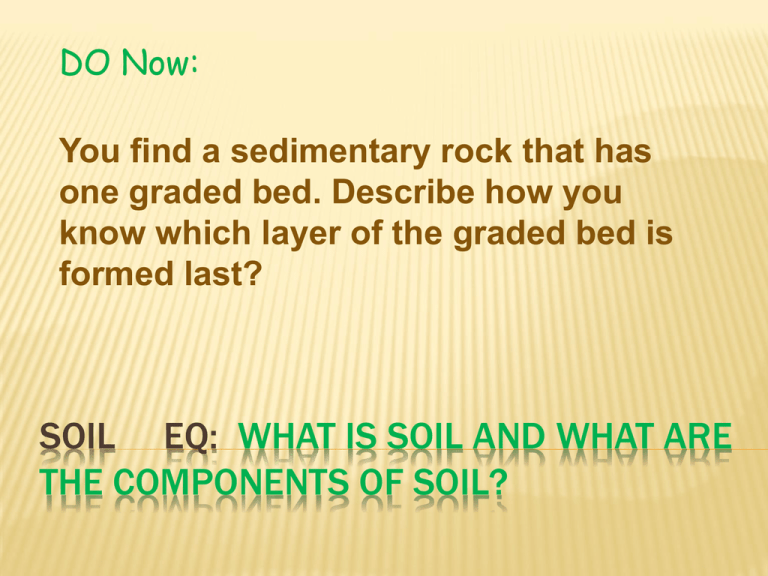SOIL
advertisement

DO Now: You find a sedimentary rock that has one graded bed. Describe how you know which layer of the graded bed is formed last? SOIL EQ: WHAT IS SOIL AND WHAT ARE THE COMPONENTS OF SOIL? EQ: What is soil and what are the components of soil? GPS: S6E5 Students will investigate the scientific view of how Earth’s surface is formed f. explain that soil is made of weathered rock and decomposed organic matter SOIL WHAT IS SOIL? Soil is the portion of Earth’s surface that consists of organic matter mixed with sediment, air, and water. Soil is a natural resource that is needed to support life on Earth. SOIL There is a big difference between “dirt” and “soil.” We use the word “dirt” to mean particles and dust that we don’t want around. Soil contains humus as well as particles of weathered rock including sand, silt, and clay. Water, air, and living organisms are also important components of soil. SOIL COMPONENTS OF SOIL Organic Material Humus – the material that is produced by the bacterial decay of plant and animal matter (organic matter). COMPONENTS OF SOIL Sediments – weathered rock Sand Silt Clay COMPONENTS OF SOIL Water, air, and living organisms SOURCE OF SOIL Soil is made from weathered rock fragments, therefore the type of soil that forms depends on the type of rock that weathers. SOIL FORMATION PARENT ROCK • The parent rock is the rock that is weathered to create the soil. Ex: If granite weathers to make soil then granite is the parent rock of that soil. SOIL FORMATION Soil is part of the rock cycle. Factors that affect soil formation include: climate, type of parent rock or mineral, presence of living organisms, topography, and time. FACTORS THAT AFFECT SOIL FORMATION 1. 2. 3. Parent Rock – affects type of soil and rate at which the soil develops Climate - soils form more quickly in warm, wet environments where weathering of parent rock is quicker/also affects the organic makeup of the soil Living Organisms – soil forms more quickly with plants, animals, bacteria, and fungi to assist with weathering/also affects the organic makeup of the soil FACTORS THAT AFFECT SOIL FORMATION (CONTINUED) 4. Topography – Steepness, shape, and length of slope are important because they influence the rate at which water flows into or off the soil, affecting the rate of soil formation. 5. Time - The longer a soil surface has been exposed to soil forming agents like rain and growing plants, the greater the development of the soil. Soils take thousands or millions of years to form. LAYERS OF SOIL A soil profile is a cross-section that shows the different layers (or horizons) of soil in the ground. Young (or immature) soil does not have as many layers as mature soil. SOIL PROFILE The soil profile is a cross section that shows the different layers of soil. CHARACTERISTICS OF THE HORIZONS OF SOIL Horizon O – dark layer of decaying sticks, leaves, and some humus. Horizon A – dark layer called topsoil that is humus and small pieces of rock. This layer is home to animals. (bugs and worms) CHARACTERISTICS OF THE HORIZONS OF SOIL Horizon B – layer called subsoil made of weathered rock pieces, clay and rocks. Horizon C – layer of weathered rock pieces and minerals. (Parent Rock) Horizon D – layer of solid rock, called bedrock. WHAT IS HUMUS? Remember – Humus is the material that is produced by the bacterial decay of plant and animal matter (organic matter). WHAT IS BEDROCK? Bedrock is the layer of solid rock formations beneath the soil. TYPES OF SOIL There are 12 soil types, or orders. Soil classification is based on the following properties: How much the soil horizons are developed Composition of different soil horizons Amount of organic material Amount of weathering and leaching of minerals Presence of calcium carbonate subsurface Location below grasslands or forests Presence of clay that shrinks and swells when mixed with water Presence of permafrost Presence of volcanic ash TYPES OF SOIL GENERAL TERMS FOR SOIL TYPES Focus on three types of soil: pedocal, pedalfer, and laterite. Pedocal forms in dry or semi-dry climates and is rich in calcium. Pedalfer forms in humid climates and is high in aluminum and iron. Laterite forms in tropical climates that have a lot of rains so it is leached of most of its elements. SOIL PROFILES SOIL TYPES EROSION AND AGRICULTURE Soil that contains a mixture of sediments, humus, air, and water is ideal for growing crops. More soil is lost each year through erosion than is formed by nature. This soil profile shows the layer of topsoil on a farm in Iowa. Due to farming, Iowa’s average topsoil depth has decreased from 14–18 inches to only 6–8 inches. SOIL FORMATION Factors that affect soil formation How? climate soil forms more quickly in wet, warm environments than in cold, dry ones type of parent rock or mineral some types of rocks weather and become soil faster than others presence of living organisms parent rocks and minerals influence color, texture, and chemistry of soil soil formation happens more quickly in the presence of living organisms decaying parts of plants and animals increase humus in soil SOIL FORMATION Factors that affect soil formation How? topography the steeper the slope, the more rocks are exposed to weathering, the faster rocks and minerals break down soil forms more quickly on top of other soil more surface area exposed, the faster a rock weathers time forming soil can take thousands to millions of years; but can be faster depending on the above factors





